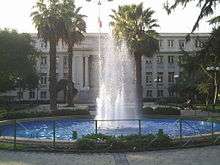Plaza Ñuñoa
Plaza Ñuñoa is found in the Ñuñoa commune of Santiago, Chile, located in the eastern part of the city. It is classic meeting place well known for its cultural centers, entertainment venues, restaurants, bars, nightlife, and ice cream stores. Plaza Ñuñoa is also where an alternative music scene fomented.[1][2]

Location
Plaza Ñuñoa is located between Irarrázaval Avenue and Duble Almeyda Avenue and between Jorge Washington street and Manuel de Salas street. The plaza also extends north of Irarrázaval Avenue. The closest metro station is Irarrázaval ![]()
![]()
History
The neighborhood development began with adjacent lots along Irarrázaval Avenue. The large palm trees on the southern side of the avenue make the plaza visually appealing. When the trolleys started passing through and small shops began to appear, activity intensified in the sector. Plaza Ñuñoa became important at the end of the 1960s, with increased urbanification of the side of the city nearer to the mountains.[4][5] In carrying out a study about social psychology, memory, and spatiality in Santiago, Chile scholars focused on Plaza Ñuñoa.[6]
In the 1980s Plaza Ñuñoa became the beer drinking destination of intellectuals and students who frequented bar Las Lanzas, a place that began to be identified as cultural and leftist.[7] There is also a bar and nightclub called La Batuta that provided a location for the burgeoning rock scene in Chile beginning in 1989.[8][9][10][11]
Established at Plaza Ñuñoa in the 1970s, Teatro Universidad Católica, formerly called Teatro Dante, is a theatre on Jorge Washington street that attracts world-class productions.[12]
Plaza Ñuñoa in literature
The plaza has provided the setting for numerous Chilean novels, including those by authors such as Dauno Tótoro Taulis, Ramón Díaz Eterovic, Cristóbal Peña, Ricardo E. Rodríguez, Jesús Sepúlveda, Elizabeth Subercaseaux and Carlos Labbé. The novel The Private Lives of Trees, by the Chilean author, Alejandro Zambra,[13] and Juan Villegas Morales' Yo Tenía un Compañero both feature the plaza.[14]
References
- Matus, Christian (1997). "Alternativo/Masivo. Una mirada de generación y género al consumo cultural de jóvenes de sectores medios". PIEG. Universidad de Chile Facultad de Ciencias Sociales. Retrieved 4 December 2012.
- "800.cl". Retrieved 4 December 2012.
- Mella, Beatriz. "Plataforma Urbana Plaza Ñuñoa". Retrieved 4 December 2012.
- "Plaza Ñuñoa". Archived from the original on 30 May 2012. Retrieved 4 December 2012.
- Caceres, G.; D. Campos; R. Greene (2005). "El despertar de la ciudad: Santiago y su renacer urbano". Bifurcaciones Revista de Estudios Culturales Urbanos. 004. Retrieved 4 December 2012.
- Goldstein, Natalia (2002). "La estructura de lugar, y el rol que juega la memoria en su configuración. Estudios sobre los espacios públicos: Plaza Egaña y Plaza Ñuñoa". Universidad de Chile Facultad de Arquitectura y Urbanismo. Cite journal requires
|journal=(help) - "Las Lanzas". Retrieved 4 December 2012.
- "La Batuta". Retrieved 4 December 2012.
- Maturana, Eduardo (January 1997). "Veinte años en mis recuerdos". Revista Musical Chilena. 51 (187).
- Bronfman, Eliama (2003). De Enterezas y Vulnerabilidades: 1973-2003, Hablan Los Mayores. LOM Ediciones, Universidad Academia de Humanismo Cristiano. ISBN 9789562826044.
- Gergen, Christopher (2008). Life Entrepreneurs: Ordinary People Creating Extraordinary Lives. Jossey-Bass. ISBN 9781118047422.
- Bennett, Colin. "Discovering Plaza Ñuñoa". Revolver. Retrieved 4 December 2012.
- Zambra, Alejandro (2010). The Private Lives of Trees. Open Letter. ISBN 9781934824245.
- Villegas Morales, Juan (2009). Yo tenía un compañero. Santiago: RIL editores. p. 302. ISBN 9789562846905.